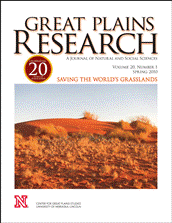Center for Great Plains Studies

Great Plains Research: A Journal of Natural and Social Sciences (through 2013)
Date of this Version
Spring 2005
Document Type
Article
Citation
Great Plains Research 15 (Spring 2005):45-67
Abstract
The Nebraska Sandhills consist of 50,000 km2 of dunes, currently stabilized by vegetation. Radiocarbon dates of paleosols, blocked paleovalleys, and sand beds found in interdunal wetlands suggest that the Holocene had significant periods of dune reactivation. A paleoecological investigation was conducted in Jumbo Valley, NE, in an interdunal wetland known to contain sand layers interbedded with peat. The sedimentary record in two cores is continuous, except for some loss due to surficial burns. Macrofossils indicate that the late Pleistocene was cool and wet, with current vegetation establishing around 12,000 years ago. Sand and bulk density profiles reveal significant periods of dune activity in the intervals 9200-7000, 6400-5400, 4000-3000, 2700-2300, 2100-1800, and 950-700 calendar years before present (cal yr BP). Profiles also indicate four significant wet intervals: 6900-6500, 4700- 4000,5200-5000, and 1300-1000 cal yr BP. Dune activity prior to 6000 cal yr BP was most likely caused by drought, while after 6000 cal yr BP, increased frequency and severity of fires appear to have also contributed. This study reveals that the Sandhills have experienced many droughts, including as recent as 950-700 cal yr BP, that were more severe than any experienced in the last century.


Comments
Published in Great Plains Research Vol. 15, No. 1, 2005. Copyright © 2005 The Center for Great Plains Studies, University of Nebraska–Lincoln. Used by permission.